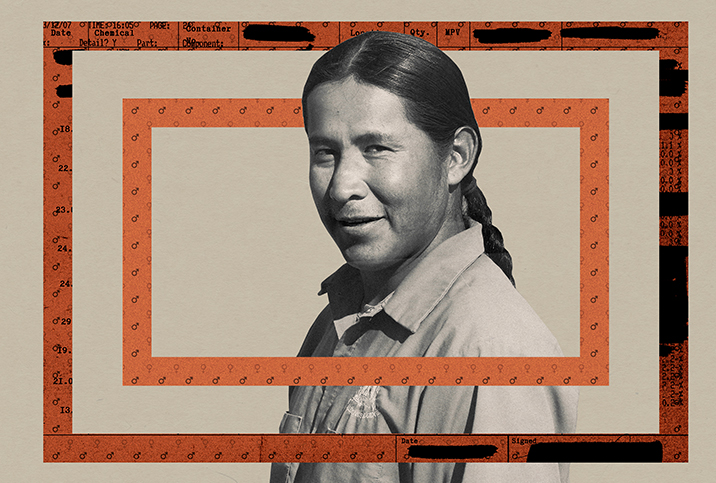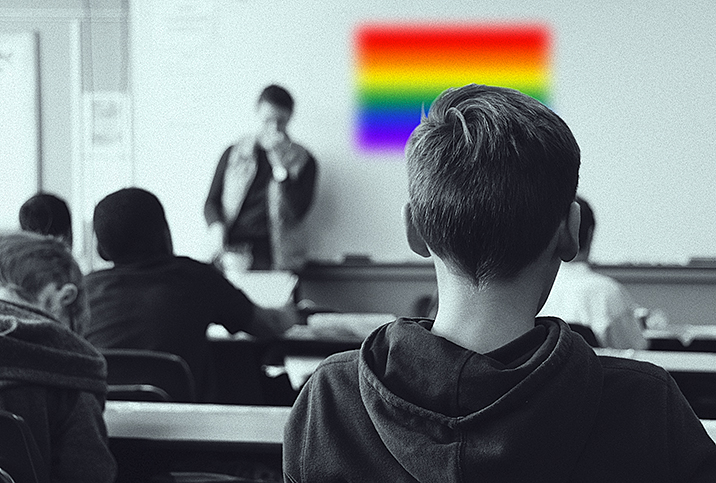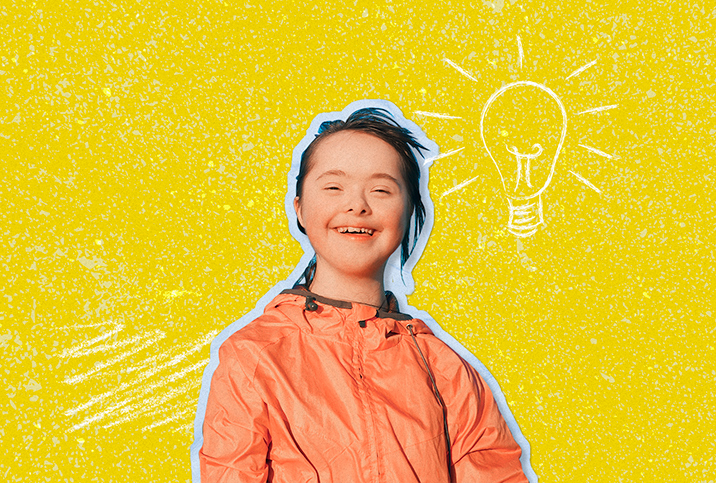The Facts About Sex Ed

Depending on when you were in middle or high school, your most lasting memory of sex ed may be either the grossly gendered "Miracle of Life" video or the abstinence-inspired "Mean Girls" scene (and ubiquitous meme) "Don't have sex. You will get pregnant and die."
The middle and high school years are the most formative era in which young people can develop healthy attitudes and behaviors toward sex, so you'd think accurate sexual education would be a priority—no matter the decade. But sex ed has a long and jumbled history in the United States, and there's still plenty of work to be done for schoolkids across the country.
From its introduction as a method of sexually transmitted disease (STD) prevention in the wake of World War I to the lingering abstinence-only method, here are the facts about sex ed and its wild history in the U.S.
The beginnings of sex ed
The basics of sexual education were introduced more than 100 years ago, with public schools using handouts and pamphlets to educate students on reproduction and pregnancy. But it wasn't until 1918 that there was anything official on the books. That was the year Congress passed The Chamberlain-Kahn Act, which established the Venereal Disease Division of the United States Public Health Service.
The reason? So many World War I soldiers contracted sexually transmitted diseases while abroad, which led to absences from duty, that the government wanted to educate them and the public about STDs in the hopes of avoiding similar outcomes in the future. One 1919 report from the U.S. Department of Labor's Children's Bureau suggested that soldiers would have been better off if they had received sex education in school.
During the Roaring Twenties—an era that rejected Victorian values to embrace a more casual approach to sex—schools began to integrate sex ed into their curriculum. The U.S. Office of Education started publishing sex ed materials and training teachers on the topic in the 1930s. In the 1940s, courses in human sexuality began to appear on college campuses, while the 1950s saw the first attempt to standardize the curricula taught in public schools with a five-part course called the "Sex Education Series," published by the American Medical Association and the Joint Committee on Health Problems of the National Education Association.
In 1964, Mary Calderone, the medical director for Planned Parenthood Federation of America, founded the Sexuality Information and Education Council of the United States (SIECUS) to provide young people and adults with accurate information about sex, sexuality and sexual health.
The introduction of abstinence-only sex ed
Despite the introduction of SIECUS, throughout the 1960s and '70s, conservative and religious groups argued that teaching teens about sex actually encouraged risky sexual behavior. When the HIV/AIDS epidemic of the 1980s hit, those groups were able to convince schools and public officials that abstinence-only sex education was the only way to keep kids "safe."
In 1990, a panel of experts convened by SIECUS created the Guidelines for Comprehensive Sexuality Education for kindergarteners through 12th-graders—a national framework to help local communities provide effective sex ed by disseminating accurate information about human sexuality; helping young people develop healthy attitudes, values and insights about human sexuality; helping young people develop the communication, decision-making, assertiveness and peer-refusal skills they need for healthy relationships; and encouraging young people to make responsible choices about sexual relationships by practicing abstinence and using contraception and having safer sex when they do become sexually active.
Abstinence-only sex ed had received federal support since 1981—when the Adolescent Family Life Act (AFLA) was signed into law, providing comprehensive support services to pregnant and parenting teens and their families while promoting "chastity" and "self-discipline"—but ALFA got a $250 million boost from the government in 1996. For the next decade (especially during the George W. Bush administration), funding continued to increase. Between 1996 and 2018, Congress allocated more than $2.1 billion in taxpayer dollars into abstinence-only-until-marriage programs.
Does abstinence-only sex ed work?
Not really. Yes, in theory abstaining from sex is the only 100 percent effective method for preventing pregnancy and sexually transmitted infections (STIs). But even young people with the best intentions sometimes fail to stick to those goals, and abstinence-only sex ed programs leave them ill-equipped to contend with the realities of sexual relationships and sexual health.
In 2007, a congressionally mandated study of abstinence-only-until-marriage programs found that this approach had no beneficial impact on young people's sexual behavior. In fact, students in the abstinence-only programs had a similar number of sexual partners and a similar age of first sexual intercourse as their peers not in the programs, the findings showed.
That same year, experts argued in the journal Current Opinion in Obstetrics and Gynecology that “abstinence-only curricula have been found to contain scientifically inaccurate information, distorting data on topics such as condom efficacy, and promote gender stereotypes.” To that end, the Bush era policies on sex education were allowed to expire in 2009.
Abstinence-only sex ed is still being taught in many places across the country, but these programs and policies in the United States were found to be ineffective in delaying sexual initiation or reducing risky sexual behaviors, according to a 2017 scientific review paper published in the Journal of Adolescent Health.
"While sexual abstinence can be a healthy choice for some adolescents, abstinence-only-until-marriage programs are highly problematic," said Laura Lindberg, review coauthor and Guttmacher principal research scientist. "These programs withhold important sexual health knowledge and provide medically inaccurate information that compromises young people's healthy sexual development."
A more modern approach to sex ed
When Barack Obama became president in 2009, he increased funds for comprehensive sex education. In doing so, he helped establish two new initiatives—the Teen Pregnancy Prevention Program (TPPP) and the Personal Responsibility Education Program (PREP)—that championed evidence-based programs that have been shown to reduce teen pregnancy and its underlying or associated risk factors.
Still, between 2006 and 2010 and 2011 and 2013, a 2016 study by the Guttmacher Institute published in the Journal of Adolescent Health found that the number of students who received formal instruction in a range of sex ed topics dropped significantly (for example, the percent of girls who learned about consent dropped from 89 percent to 82 percent, while the percent of boys who learned about birth control dropped from 61 percent to 55 percent).
In 2015, additional funding was granted through TPPP to create these evidence-based programs in communities with the greatest need; increase capacity of organizations to implement evidence-based TPPP programs focusing on serving especially vulnerable groups, including homeless youth, pregnant and parenting youth, and youth in the juvenile detention and foster care systems; support and foster early innovations to fill gaps in the knowledge of what works to prevent teen pregnancy; and develop and rigorously evaluate new, innovative approaches to reducing unplanned teen pregnancy.
According to the Centers for Disease Control and Prevention, quality sexual health education programs teach students how to analyze family, peer and media influences that impact health; access valid and reliable health information, products, and services (e.g., HIV/STD testing); communicate with family, peers and teachers about issues that affect health; make informed and thoughtful decisions about their health; and take responsibility for themselves and others to improve their health.
Unfortunately, only 43 percent of high schools and 18 percent of middle schools actually teach key CDC topics for sexual health education.
It didn't help that President Donald Trump's administration tried to slash funding for the Teen Pregnancy Prevention Program in 2017, and announced a shift in funding toward abstinence-only policies in 2018.
As of October 2020, 30 states and the District of Columbia require public schools to teach sex education and 39 states and the District of Columbia require students receive instruction about HIV, but only 22 states require that if provided, sex and/or HIV education must be medically, factually or technically accurate, according to the National Conference of State Legislatures.
But President Joe Biden has stated that he "supports comprehensive and age-appropriate sex education that includes science-based prevention methods" as far back as 2007. Experts are recommending that his administration prioritize access to comprehensive sex education programs by passing the Real Education for Healthy Youth Act, which would fund teacher training on sex education and provide grants for comprehensive sex education to public or private entities that focus on adolescent health and education or have experience with training sex educators.
And while 91 percent of adults think that teenagers having sex before marriage is generally wrong, 91 percent of adults in the U.S. still favor sex education in public schools, according to the HRC Foundation, a nonprofit that works to improve the lives of LGBTQ people. An older but no less relevant YouGov poll from 2015 found that 66 percent—a majority across political parties—support teenagers being taught about various methods of birth control as opposed to abstinence only.
Considering that there's significant evidence—recapped most recently in research published in 2021 in the Journal of Adolescent Health—that supports sex education, including LGBTQ-inclusive sex education, beginning in elementary school, it seems the U.S. is moving toward more effective and inclusive sex ed programs and policies that will serve to help younger generations.


















